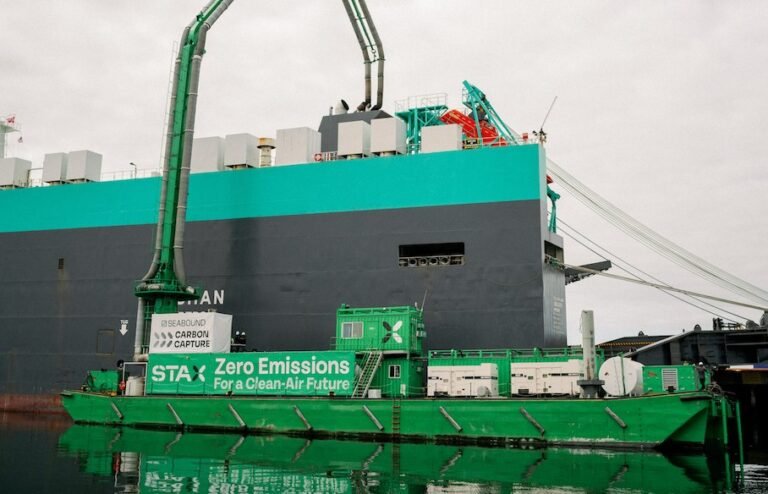STAX Engineering and Seabound Demonstrate Integrated Emissions and Carbon Capture Solution
STAX Engineering, a California-based company specializing in maritime emissions capture and control, and Seabound, a UK-headquartered onboard carbon capture firm, have recently showcased a groundbreaking integrated emissions and carbon capture solution.
The fully integrated modular solution has successfully completed its final trial and is now poised for potential deployment with the Associated British Ports (ABP).
At an event held in the Port of Long Beach, the two companies demonstrated their combined emissions-reduction technologies in action. The system, mounted on a STAX barge, effectively serviced a roll-on roll-off (RoRo) vessel from Wallenius Wilhelmsen (WWL), filtering out harmful pollutants such as particulate matter (PM) and nitrogen oxide (NOx) while capturing carbon dioxide directly from the vessel’s exhaust.
This significant achievement represents a major milestone in port emissions reduction efforts, particularly in light of the industry’s increasing focus on addressing carbon emissions.
STAX CEO, Mike Walker, expressed his excitement about the milestone, stating, “Today marks a landmark moment in our journey toward a zero-emissions future, and it’s just the beginning of a global maritime emissions solution.”
Co-founder and CEO of Seabound, Alisha Fredriksson, emphasized the importance of the partnership, stating, “Our collaboration with STAX proves that by leveraging innovative onboard carbon capture, we can make a tangible difference on a global scale and provide the maritime industry with the tools vital for a sustainable future.”
The successful collaboration between STAX and Seabound caught the attention of ABP, leading to their participation in ABP’s Energy Ventures Accelerator program, aimed at supporting clean energy startups to help achieve Net Zero by 2040.
The integrated system combines STAX’s mobile emissions control unit, capable of removing 99% of PM and 95% of NOx, with Seabound’s carbon capture technology. This system effectively captures carbon and sulfur emissions before releasing the cleaned exhaust back into the environment.
Since its inception, STAX has made significant strides in emissions control, capturing over 126 tons of pollutants and securing funding for fleetwide carbon capture integration and international expansion.
On the other hand, Seabound recently completed a successful demonstration of their onboard carbon capture system and is gearing up to launch commercial carbon capture systems later this year.
The collaboration between STAX and Seabound not only showcases the potential of innovative emissions reduction technologies but also highlights the impact of UK-US partnerships in shaping a cleaner and more sustainable maritime industry.

